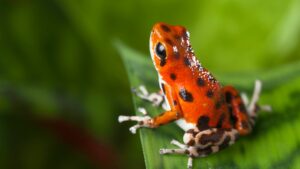Adorable Amphibians: Nature’s Colorful Muses and Environmental Guardians
In a world teeming with fascinating creatures, the cute frog stands out as a charming ambassador of the amphibian realm. With their vibrant colors and endearing behaviors, these small hoppers capture the hearts of nature enthusiasts and casual observers alike. Their presence in diverse ecosystems highlights their adaptability and ecological importance.
Beyond their ecological significance, cute frogs have also become cultural icons, inspiring art, folklore, and even fashion. As people become more aware of their ecological roles, the appreciation for these amphibians continues to grow, reminding us of the delicate balance within our natural world.
Understanding The Appeal Of Cute Frogs

Cute frogs captivate audiences through their striking appearances and engaging behaviors. Their vibrant colors—like the dazzling hues of the poison dart frog—attract attention, making them favorites for wildlife photographers. Beyond their looks, cute frogs’ playful antics, such as the red-eyed tree frog’s high jumps, enchant onlookers worldwide. These amphibians serve as symbols of environmental resilience, representing thriving ecosystems.
Cultural factors also boost the appeal of cute frogs. From traditional folklore to contemporary art, they symbolize transformation and adaptation, appearing in children’s books, the gaming industry, and animated films. Their presence in media fosters admiration, influencing fashion trends through frog-themed apparel and accessories. Moreover, cute frogs inspire conservation efforts as their sensitive skin makes them vital indicators of environmental health. Ecologists study them for insights into ecosystem stability, reinforcing public desire to protect their habitats. Consequently, the allure of cute frogs intertwines ecology with culture, enhancing their charm and significance.
Popular Cute Frog Species
Several species of cute frogs capture attention with their unique attributes. The Red-Eyed Tree Frog, with its striking red eyes and bright green body, is often seen in tropical rainforests. Its vivid coloration deters predators, making it a popular subject for wildlife photographers.

The Poison Dart Frog boasts an array of vibrant colors, from sunny yellow to deep blue. Although tiny, these cute frogs are highly recognized for their bold patterns, which also serve as a warning signal to potential threats.
Another captivating species is the Vietnamese Mossy Frog, known for its camouflage abilities. Its bumpy, moss-like skin allows it to blend seamlessly into its surroundings in northern Vietnam forests. This species demonstrates the unique adaptations seen in cute frog varieties, enhancing their charm.
The Amazon Milk Frog, notable for its smooth, bluish-gray skin and contrasting black patches, adds to the list of popular cute frogs. These frogs originate from the warm and humid Amazon Basin, where their striking appearance complements the region’s biodiversity.
Cute Frogs In Pop Culture

Cute frogs often pop up in pop culture, making appearances in films, TV shows, and games. Kermit the Frog, a beloved character from “The Muppet Show,” exemplifies this influence with his endearing personality and musical talents. He stands as a symbol of hope and humor for audiences worldwide. Animated films, like Disney’s “The Princess and the Frog,” introduce cute frogs as central characters, capturing hearts and teaching valuable life lessons. Children’s books, such as Arnold Lobel’s “Frog and Toad,” highlight friendships and adventures, further solidifying frogs’ presence in pop culture.
The gaming world embraces cute frogs too. Characters like Froakie, a starter Pokémon in the franchise, showcase their charm and versatility. Virality amplifies this impact, with frog-themed memes and social media posts spreading across platforms. Cute frogs capture cultural consciousness, maintaining their appeal across diverse media forms while fostering enduring affection.
Tips For Caring For Pet Frogs
Cute frogs captivate with their vibrant colors and playful antics, and many enthusiasts consider keeping them as pets. To ensure their well-being, it’s crucial to replicate their natural habitat. A terrarium with appropriate humidity, temperature, and hiding spots is essential. Feeding them a diet of live insects like crickets and mealworms supports their nutritional needs. Regular cleaning of their enclosure prevents disease, while monitoring water quality is vital due to their sensitive skin. Engaging with them gently and observing their behaviors can provide insights into their health and happiness. By understanding their unique requirements, frog owners can enjoy a rewarding relationship with these charming amphibians.


